JavaScript is disabled for your browser. Some features of this site may not work without it.
Buscar en RiuNet
Listar
Mi cuenta
Estadísticas
Ayuda RiuNet
Admin. UPV
Robust estimation of axial loads sustained by tie-rods in historical structures using Artificial Neural Networks
Mostrar el registro sencillo del ítem
Ficheros en el ítem
| dc.contributor.author | Makoond, Nirvan Chandra
|
es_ES |
| dc.contributor.author | Pelà, Luca
|
es_ES |
| dc.contributor.author | Molins, Climent
|
es_ES |
| dc.date.accessioned | 2023-10-19T18:02:02Z | |
| dc.date.available | 2023-10-19T18:02:02Z | |
| dc.date.issued | 2023-07 | es_ES |
| dc.identifier.issn | 1475-9217 | es_ES |
| dc.identifier.uri | http://hdl.handle.net/10251/198421 | |
| dc.description.abstract | [EN] Widely used simplified analytical methods for estimating the tensile force in tie-rods are clearly not applicable when they contain significant discontinuities or irregularities. A common example for which this fact becomes relevant in practice is the use of connectors to unify historical ties consisting of several segments. To address this challenge, a robust hybrid methodology is proposed which can be applied to any historical tie by employing a data-driven approach to a dataset generated using the finite element method. The methodology is applied to a real case study involving two historical ties. | es_ES |
| dc.description.sponsorship | The author(s) disclosed receipt of the following financial support for the research, authorship, and/or publication of this article: This work was supported by the Servei del Patrimoni Arquitectònic of the Generalitat de Catalunya through a project (managed by the City Council of Sant Cugat) aimed at monitoring the church of the Monastery of Sant Cugat (grant number C-10764); the Ministry of Science, Innovation and Universities of the Spanish Government and the ERDF (European Regional Development Fund) through the SEVERUS project (Multilevel evaluation of seismic vulnerability and risk mitigation of masonry buildings in resilient historical urban centres) (grant number RTI2018-099589-B-I00); and the AGAUR agency of the Generalitat de Catalunya in the form of the predoctoral grant of the first author. | es_ES |
| dc.language | Inglés | es_ES |
| dc.publisher | SAGE Publications | es_ES |
| dc.relation.ispartof | Structural Health Monitoring | es_ES |
| dc.rights | Reserva de todos los derechos | es_ES |
| dc.subject | Axial force estimation | es_ES |
| dc.subject | Vibration testing | es_ES |
| dc.subject | Dynamic identification | es_ES |
| dc.subject | Modal analysis | es_ES |
| dc.subject | Natural frequency | es_ES |
| dc.subject | Mode shapes | es_ES |
| dc.title | Robust estimation of axial loads sustained by tie-rods in historical structures using Artificial Neural Networks | es_ES |
| dc.type | Artículo | es_ES |
| dc.identifier.doi | 10.1177/14759217221123326 | es_ES |
| dc.relation.projectID | info:eu-repo/grantAgreement/AEI/Plan Estatal de Investigación Científica y Técnica y de Innovación 2017-2020/RTI2018-099589-B-I00/ES/EVALUACION MULTINIVEL DE LA VULNERABILIDADD SISMICA Y MITIGACION DE RIESGO DE EDIFICIOS DE OBRA DE FABRICA EN CENTROS URBANOS HISTORICOS RESILIENTES/ | es_ES |
| dc.relation.projectID | info:eu-repo/grantAgreement/GC//C-10764//Servei del Patrimoni Arquitectònic/ | es_ES |
| dc.rights.accessRights | Abierto | es_ES |
| dc.description.bibliographicCitation | Makoond, NC.; Pelà, L.; Molins, C. (2023). Robust estimation of axial loads sustained by tie-rods in historical structures using Artificial Neural Networks. Structural Health Monitoring. 22(4):2496-2515. https://doi.org/10.1177/14759217221123326 | es_ES |
| dc.description.accrualMethod | S | es_ES |
| dc.relation.publisherversion | https://doi.org/10.1177/14759217221123326 | es_ES |
| dc.description.upvformatpinicio | 2496 | es_ES |
| dc.description.upvformatpfin | 2515 | es_ES |
| dc.type.version | info:eu-repo/semantics/publishedVersion | es_ES |
| dc.description.volume | 22 | es_ES |
| dc.description.issue | 4 | es_ES |
| dc.relation.pasarela | S\486293 | es_ES |
| dc.contributor.funder | Generalitat de Catalunya | es_ES |
| dc.contributor.funder | Agencia Estatal de Investigación | es_ES |
| dc.contributor.funder | European Regional Development Fund | es_ES |
| dc.contributor.funder | Agencia de Gestión de Ayudas Universitarias y de Investigación | es_ES |
| dc.subject.ods | 09.- Desarrollar infraestructuras resilientes, promover la industrialización inclusiva y sostenible, y fomentar la innovación | es_ES |
| dc.subject.ods | 11.- Conseguir que las ciudades y los asentamientos humanos sean inclusivos, seguros, resilientes y sostenibles | es_ES |







![[Cerrado]](/themes/UPV/images/candado.png)

